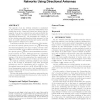Free Online Productivity Tools
i2Speak
i2Symbol
i2OCR
iTex2Img
iWeb2Print
iWeb2Shot
i2Type
iPdf2Split
iPdf2Merge
i2Bopomofo
i2Arabic
i2Style
i2Image
i2PDF
iLatex2Rtf
Sci2ools
111
Voted
MOBIHOC
2003
ACM
2003
ACM
On the capacity improvement of ad hoc wireless networks using directional antennas
The capacity of ad hoc wireless networks is constrained by the interference between concurrent transmissions from neighboring nodes. Gupta and Kumar have shown that the capacity of an ad hoc network does not scale well with the increasing number of nodes in the system when using omnidirectional antennas [6]. We investigate the capacity of ad hoc wireless networks using directional antennas. In this work, we consider arbitrary networks and random networks where nodes are assumed to be static. In arbitrary networks, due to the reduction of the interference area, the capacity gain is proven to be 2 when using directional transmission and omni reception. Because of the reduced probability of two neighbors pointing to each other, the capacity gain is 2 when omni transmission and directional reception are used. Although these two expressions look similar, the proof technique is different. By taking advantage of the above two approaches, the capacity gain is 2 when both transmission and r...
Directional Antennas | Directional Transmission/directional Reception | Directional Transmission/omni Reception | MOBIHOC 2003 | Wireless Networks |
Related Content
| Added | 25 Dec 2009 |
| Updated | 25 Dec 2009 |
| Type | Conference |
| Year | 2003 |
| Where | MOBIHOC |
| Authors | Su Yi, Yong Pei, Shivkumar Kalyanaraman |
Comments (0)

